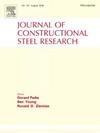冷弯钛包双金属角钢截面桩柱的火灾后行为
IF 4
2区 工程技术
Q1 CONSTRUCTION & BUILDING TECHNOLOGY
引用次数: 0
摘要
这项研究包括一系列实验和详细的数值分析,以揭示冷成形钛包双金属钢(TCBS)角截面支柱(ASSC)暴露于高温后的截面行为和残余压缩极限能力。测试了四种不同几何尺寸的冷成形 TCBS ASSC。暴露温度包括 20°C、700°C 和 900°C。实验结束后,进行了全面的数值分析,其中包括 200 个有限元模型。由于缺乏针对冷成形 TCBS 结构的专门设计方法,因此评估了碳钢结构的传统设计方法对承受高温的冷成形 TCBS ASSC 的适用性,其中考虑了 EN 1993-1-1、AISI 100 和直接强度法中的设计方法。结果发现,针对火灾后冷成形 TCBS ASSC 的现有设计方法缺乏精确性。因此,对 EN 1993-1-1 中的设计方法提出了修改建议,以提高对暴露于高温后的冷成形 TCBS ASSC 的残余抗压极限承载力的预测精度。这为评估冷弯 TCBS 结构的火灾后适用性奠定了基础。本文章由计算机程序翻译,如有差异,请以英文原文为准。
Post-fire behavior of cold-formed titanium-clad bimetallic steel angle section stub columns
This study included a series of experiments and a detailed numerical analysis to reveal the cross-sectional behaviors and residual compression ultimate capacities of cold-formed titanium-clad bimetallic steel (TCBS) angle section stub columns (ASSCs) following exposure to high temperatures. Four cold-formed TCBS ASSCs with different geometric dimensions were tested. The exposure temperature included 20 °C, 700 °C, and 900 °C. After experiment, a comprehensive numerical analysis was carried out, wherein 200 finite element models were included. Given the lack of specialized design approaches for cold-formed TCBS structures, the applicability of conventional design approaches for carbon steel structures to cold-formed TCBS ASSCs subjected to high temperatures was assessed, where the design approaches in EN 1993-1-1, AISI 100, and the Direct Strength Method were considered. It was found that the existing design approaches for post-fire cold-formed TCBS ASSCs lacked precision. Hence, modifications to the design approach in EN 1993-1-1 were proposed to improve the accuracy on the prediction of the residual compressive ultimate capacities of cold-formed TCBS ASSCs following exposure to high temperatures. This provided the foundation for evaluating the post-fire serviceability of cold-formed TCBS structures.
求助全文
通过发布文献求助,成功后即可免费获取论文全文。
去求助
来源期刊

Journal of Constructional Steel Research
工程技术-工程:土木
CiteScore
7.90
自引率
19.50%
发文量
550
审稿时长
46 days
期刊介绍:
The Journal of Constructional Steel Research provides an international forum for the presentation and discussion of the latest developments in structural steel research and their applications. It is aimed not only at researchers but also at those likely to be most affected by research results, i.e. designers and fabricators. Original papers of a high standard dealing with all aspects of steel research including theoretical and experimental research on elements, assemblages, connection and material properties are considered for publication.
 求助内容:
求助内容: 应助结果提醒方式:
应助结果提醒方式:


